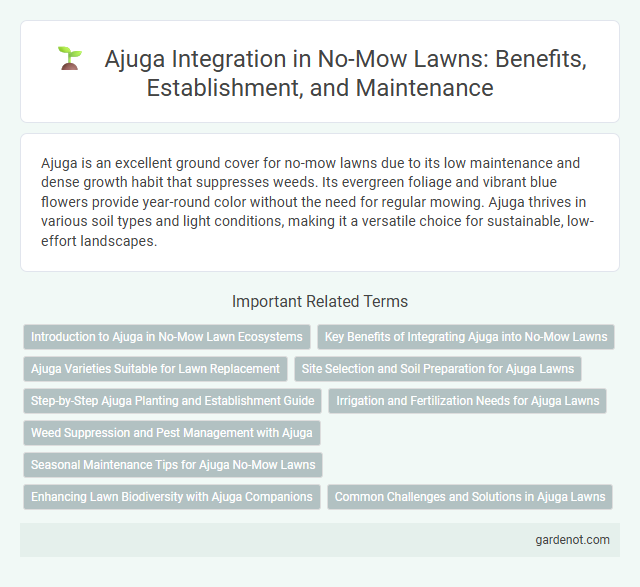Ajuga is an excellent ground cover for no-mow lawns due to its low maintenance and dense growth habit that suppresses weeds. Its evergreen foliage and vibrant blue flowers provide year-round color without the need for regular mowing. Ajuga thrives in various soil types and light conditions, making it a versatile choice for sustainable, low-effort landscapes.
Introduction to Ajuga in No-Mow Lawn Ecosystems
Ajuga, also known as bugleweed, is a low-growing groundcover ideal for no-mow lawn ecosystems due to its dense foliage and rapid spreading ability. This perennial plant thrives in shady to partially shaded areas, providing excellent soil erosion control and suppressing weed growth naturally. Its vibrant blue flowers and evergreen leaves enhance biodiversity while reducing maintenance needs in sustainable landscaping designs.
Key Benefits of Integrating Ajuga into No-Mow Lawns
Ajuga enhances no-mow lawns by providing dense ground cover that suppresses weeds and reduces soil erosion, ensuring a healthy and low-maintenance landscape. Its vibrant foliage and blue flower spikes add year-round visual interest without the need for regular mowing or trimming. Ajuga's adaptability to various soil types and shade tolerance makes it an ideal choice for sustainable, water-efficient no-mow lawn designs.
Ajuga Varieties Suitable for Lawn Replacement
Ajuga varieties such as Ajuga reptans 'Chocolate Chip', 'Bronze Beauty', and 'Catlin's Giant' are excellent choices for lawn replacement due to their dense ground cover and low maintenance requirements. These varieties thrive in partial shade to full sun and offer vibrant foliage colors that enhance landscape aesthetics while suppressing weeds. Quick to establish and drought-tolerant once mature, Ajuga provides a sustainable, no-mow lawn alternative ideal for reducing water usage and lawn care efforts.
Site Selection and Soil Preparation for Ajuga Lawns
Ajuga thrives best in well-drained, fertile soils with pH levels between 6.0 and 7.5, making site selection crucial for a healthy no-mow lawn. Choose a location with partial shade to full sun, as Ajuga prefers moderate sunlight but tolerates shade without compromising ground cover density. Prepare the soil by removing weeds, loosening the top 6 inches, and incorporating organic matter to promote moisture retention and nutrient availability essential for vigorous growth.
Step-by-Step Ajuga Planting and Establishment Guide
Ajuga is an ideal ground cover for no-mow lawns due to its low maintenance and rapid spread. Begin planting by preparing well-drained soil, spacing Ajuga plants 6 to 12 inches apart to ensure dense coverage. Water regularly during the initial establishment phase and mulch lightly to retain moisture while suppressing weeds, enabling Ajuga to create a lush, colorful carpet that requires minimal mowing.
Irrigation and Fertilization Needs for Ajuga Lawns
Ajuga lawns require moderate irrigation, with soil kept consistently moist but not waterlogged to prevent root rot and encourage healthy growth. Fertilization should be minimal, using a balanced, slow-release fertilizer in early spring to promote vibrant foliage without excessive nitrogen that can lead to legginess. Proper watering and feeding schedules ensure Ajuga maintains a dense, weed-suppressing ground cover in no-mow lawn settings.
Weed Suppression and Pest Management with Ajuga
Ajuga is an effective ground cover in no-mow lawns, providing dense foliage that suppresses weed growth by limiting sunlight and space for invasive plants. Its natural resistance to pests reduces the need for chemical treatments, promoting a healthier, low-maintenance landscape. This combination of weed suppression and pest management makes Ajuga ideal for sustainable lawn care solutions.
Seasonal Maintenance Tips for Ajuga No-Mow Lawns
Ajuga thrives with minimal mowing, making it ideal for no-mow lawns, but seasonal maintenance is crucial for optimal growth and ground coverage. In early spring, trim back any damaged or dead foliage to encourage fresh shoots, while regular watering during dry spells helps maintain its vibrant carpet-like appearance. Applying a balanced, slow-release fertilizer in mid-spring supports lush growth, and removing flower spikes after blooming prevents seeding and promotes extended ground cover.
Enhancing Lawn Biodiversity with Ajuga Companions
Ajuga, a low-growing ground cover with vibrant blue flowers, significantly enhances lawn biodiversity by supporting pollinators and providing a natural habitat for beneficial insects. Integrating Ajuga companions such as clover, creeping thyme, and native grasses increases soil health and pest resistance while reducing the need for mowing and chemical treatments. This no-mow lawn strategy fosters a resilient, eco-friendly landscape that promotes ecosystem balance and sustainable lawn care.
Common Challenges and Solutions in Ajuga Lawns
Ajuga lawns often face challenges such as poor drainage, leading to root rot and fungal diseases, which can be mitigated by improving soil aeration and ensuring proper water runoff. Weed invasion is another common issue, requiring regular monitoring and selective herbicide application to maintain Ajuga's dense ground cover. To prevent thinning and bare patches, overseeding with Ajuga runners or planting incrementally during mild seasons supports a robust and healthy lawn.
Ajuga Infographic

 gardenot.com
gardenot.com